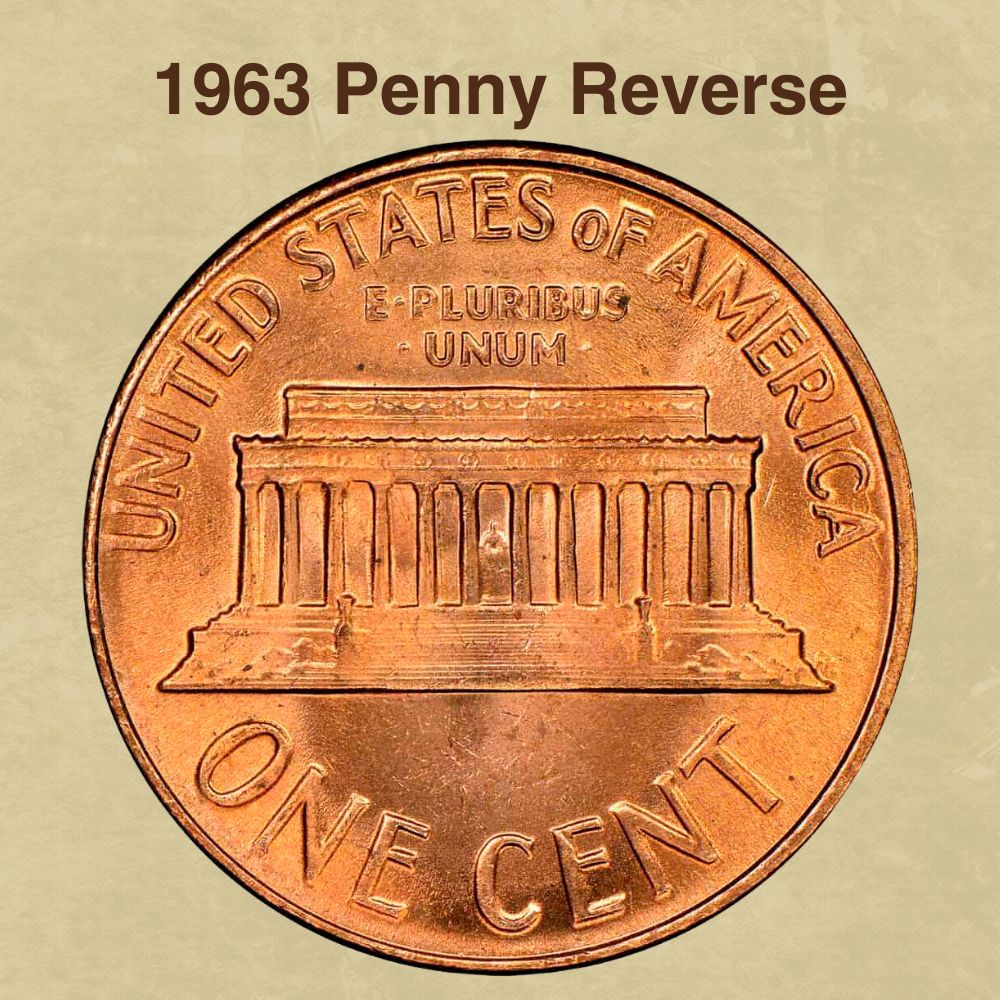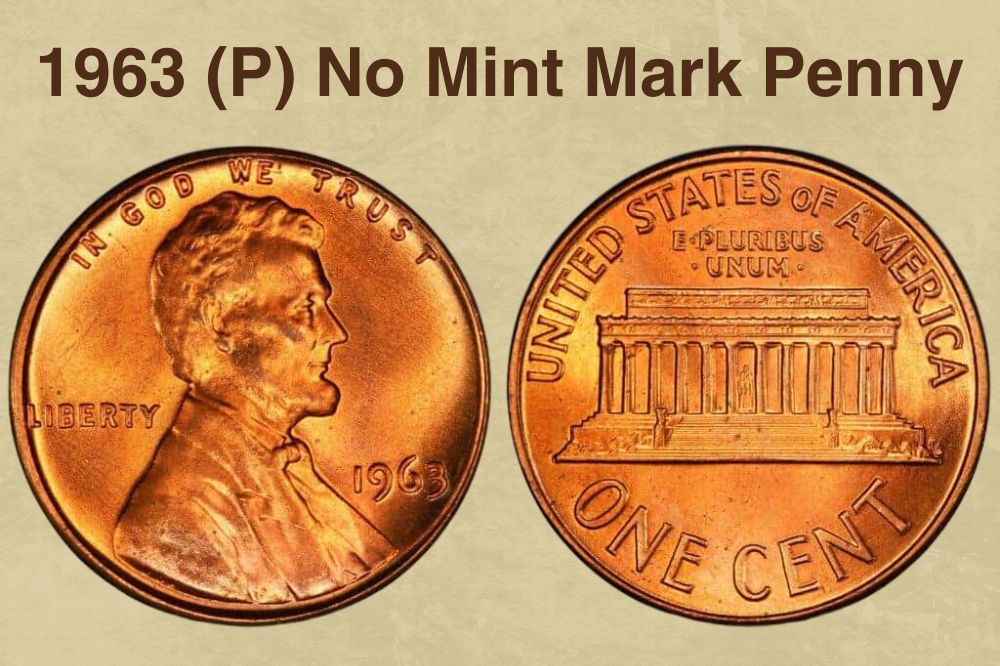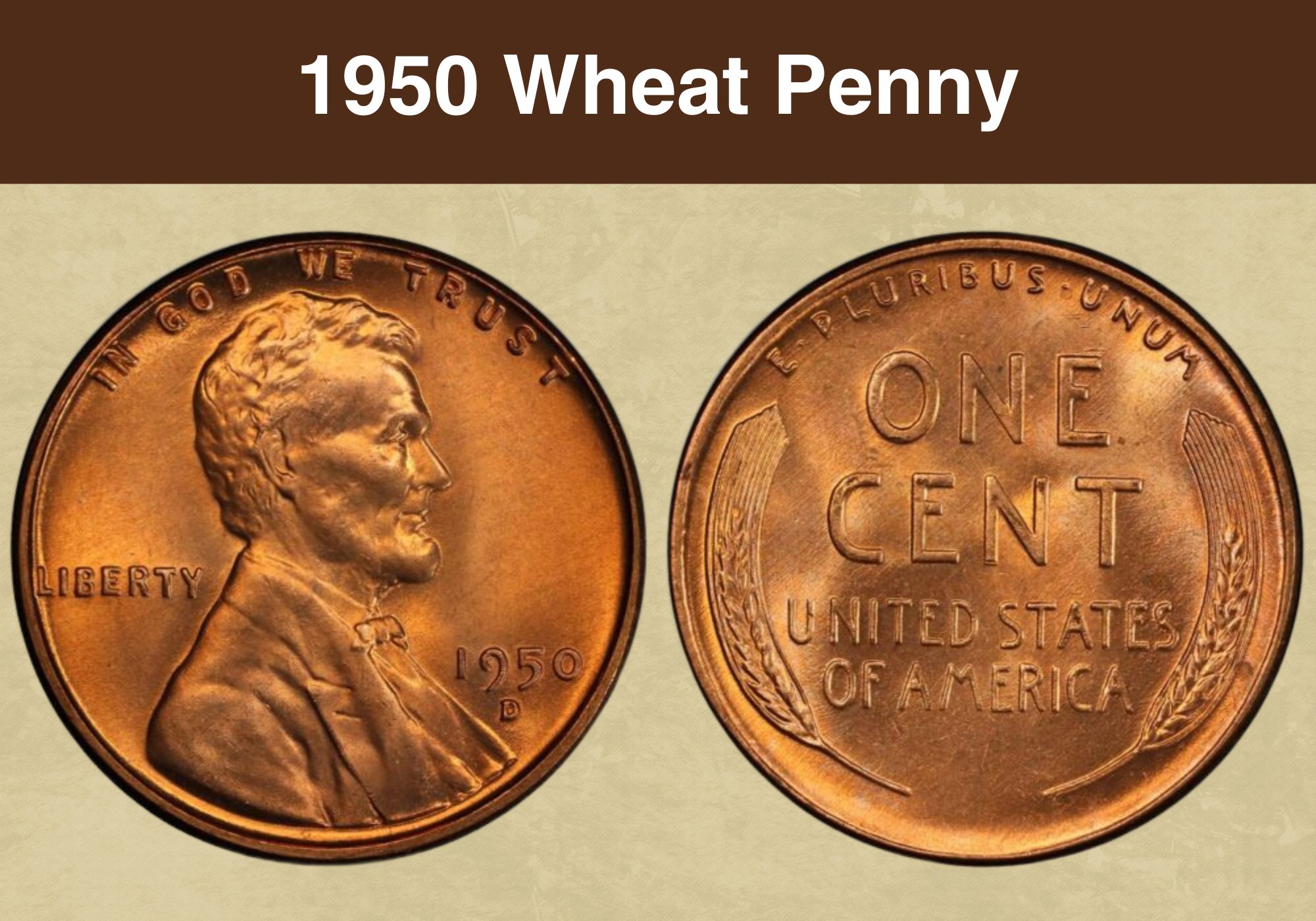
Coin Value Contents Table
Have you found a penny dated 1963 in your pocket change? Or perhaps you collect pennies and are thinking about adding a new mintage to your collection?
Either way, you’ve come to the right place! We’re going to investigate the 1963 penny value and the factors that influence it. And we’ll discover what distinguishes a valuable penny from something ordinary.
Ready to get started? Read on!
1963 Penny Value Chart* |
|||
| Mint mark | MS63 | MS65 | MS67 |
| 1963 (P) No Mint Mark Penny Value | $6 | $20 | $800 |
| 1963 D Penny Value | $3 | $20 | $14,500 |
|
|
PR63 | PR65 | PR67 |
| 1963 (P) No Mint Mark Proof Penny Value | $10
Cameo: $11 Deep cameo: $14 |
$14
Cameo: $16 Deep cameo: $18 |
$22
Cameo: $26 Deep cameo: $28 |
*Values shown are for coins graded red (RD).
History of the 1963 Penny
The penny minted in 1963 was part of a tradition that stretched back to 1909. That year marked a century since the birth of the former US president, Abraham Lincoln.
To mark the occasion, the US Mint produced a new design for the penny, or 1 cent coin. It was the first penny ever to feature Lincoln. And it was also the first time a real person had ever been depicted on a US coin.
The portrait of Lincoln that appears on the 1963 penny is just the same as those first versions. The design on the reverse, though, is different.
The first Lincoln pennies had a simple image of two ears of wheat. But after 50 years, it was decided it was time for a change.
The new design instead showed the Lincoln Memorial in Washington DC. The image includes the statue of Lincoln in the portico, making it one of the few coins to portray the same person on both sides.
This design that was still being used in 1963. Indeed, it continued to appear on all Lincoln pennies until 2008, when it was replaced with the Union shield.
The 1963 penny differed in other respects from earlier pennies too. Although they weighed the same – 3.11 grams – their composition was slightly different.
The majority of early pennies were made of bronze – 95 per cent copper, with the remainder a mixture of tin and zinc. But later, the tin was removed from the equation. The pennies struck in 1963 were made of 95 per cent copper and 5 per cent zinc, making them brass not bronze.
The modification was intended to make the coins easier to manufacture, without affecting their durability. Congress approved the change in September 1962.
Also read: 12 Most Valuable Lincoln Penny Worth Money
Features of the 1963 Penny
The Obverse of the 1963 Penny
The obverse – the “heads” side – of the 1963 penny will look very familiar to any American. It shows the same image of President Abraham Lincoln that appears on cents today. And it’s been that way for well over a hundred years.
Lincoln’s portrait was the creation of an artist by the name of Victor David Brenner. Brenner said that he had imagined Lincoln as he would have looked when reading to a child. His intention was to give the President a lively expression.
It’s generally believed that Brenner worked from a photograph of Lincoln which had been taken at the studio of one Matthew Brady. Opinions differ on whether the photograph was taken by Brady himself, or by one of his assistants.
Brenner had originally proposed signing his portrait, but Mint officials felt that would be unacceptable. So Brenner compromised by placing only his initials on the reverse.
But while initialling their designs had been normal practice for coin designers, on this occasion it caused a stir. Some felt that Brenner’s initials were too prominent, and amounted to advertising. In the face of the complaints, the Mint decided to remove his initials altogether.
They were eventually reinstated in a new position in 1918. Look closely at the cut-off of Lincoln’s bust on the 1963 penny, and you’ll see “VDB” tucked away discreetly there.
The familiar motto “In God We Trust” is inscribed above the portrait. “Liberty” appears on the left as the coin is viewed, and the date is on the right.
If your 1963 penny was minted in Denver, it will also have a mint mark. The small “D” appears on the obverse too, just below the date.
The Reverse of the 1963 Penny
The 1963 penny has the image of Washington DC’s Lincoln Memorial on its reverse. It was first used in 1959, marking 150 years since Lincoln’s birth.
The denomination is inscribed boldly below the image, following the curve of the lower coin edge. The country name is in smaller letters at the top of the coin, again curving to follow the edge of the coin.
The Latin motto “E pluribus unum” appears below the country name, inscribed over two horizontal lines. The words are a reference to the creation of the USA from individual states. They translate to English as “From the many, one”.
Other Features of the 1963 Penny
The copper content of 1963 pennies is the same as for most earlier Lincoln pennies, at 95 per cent. But where the remainder had previously been a mixture of tin and zinc, the tin was removed in 1962. The idea was to make the coin easier to manufacture.
The change didn’t affect the coin’s weight, which remained 3.11 grams. And its dimensions remained the same too, with a diameter of 19 millimeters.
Because of the high copper content, the color of 1963 pennies varies widely. Those that have had minimal handling or exposure to the air retain the red tone of new copper. But if they’ve been handled more often, that red will dull to brown.
The color grading of a bronze or brass coin is therefore important to its value. Coins that are red over at least 95 per cent of their total surface area are classed as “red”. These are usually the most desirable to collectors.
At the other end of the spectrum are coins that are brown over the same proportion of their total surface area. Those are categorized as “brown”, while anything in between is “red and brown”.
You can learn more about how to grade the color of your Lincoln penny in this YouTube video from CoinOpp.
Also read: 13 Most Valuable Wheat Penny Worth Money
1963 Penny Grading
| # | Grade |
|---|---|
| 1 | Basal State-1 |
| 2 | Fair |
| 3 | Very Fair |
| 4, 5, 6 | Good |
| 7, 8, 10 | Very Good |
| 12, 15 | Fine |
| 20, 30 | Very Fine |
| 40 | Extremely Fine |
| 50 | About Uncirculated |
| 60 | Mint State |
| 65 | Mint State |
| 70 | Mint State |
Please check our grading guides to know your coin scale, It’s the necessary step to know the exact value of your coin.
Check out now: How to Grade Lincoln Wheat Penny?
1963 Penny Value Guides
1963 (P) No Mint Mark Penny Value
To check if your penny was minted in Philadelphia, take a look at the obverse. If there’s no letter beneath the date, it’s a Philadelphia penny. That’s because Philly was the first of the US Mint facilities, so originally had no need of a mint mark.
1963 saw it strike over 750 million Lincoln pennies. So it’s perhaps not surprising that these are still pretty easy to find. And it’s even possible to find “mint state” coins in circulation today.
The value depends on the color of the coin and its condition. The quality and condition of coins is graded from 1 to 70, with 70 the highest. Mint state coins are graded from 60 upwards. And the 1963 penny is relatively common at all grades up to MS63.
Unless your brown or red and brown coin has an interesting error – and we’ll look at some of those later – it’s probably only worth its face value. But red coins at higher grades can be worth far more.
At MS63, a red 1963 Philadelphia penny is worth about $6, according to the independent coin graders, the PCGS. That’s 600 times its face value – not bad for a coin you have a chance of finding in your pocket change.
And at higher levels, they become much rarer. A red example graded MS65 is worth around $20. At MS67, only 19 coins have been certified by the PCGS. They’re worth around $775 each.
The finest examples known to exist are two coins graded MS67+. Those are each valued at an astonishing $9,000.
1963 D Penny Value
When it came to 1963 pennies, the Denver Mint facility was prolific. It struck more than 1.77 billion, more than twice as many as came out of the Philadelphia coin presses. If there’s a small “D” below the date on your coin, it’s one of the Denver examples.
As with the Philadelphia pennies, the vast majority of brown or red and brown coins are worth just a cent. But it’s harder to find red Denver pennies at the highest grades.
For MS63 red coins, the value mirrors Philadelphia examples at $3. But if you find a coin graded higher than MS65, values are much higher.
A red Denver 1963 penny graded MS66 is worth about $80. That’s almost three times as much as the Philadelphia equivalent. Values rise to $450 at MS66+, and top out at MS67. The PCGS values the five coins it’s certified at that level at a cool $14,500 apiece.
1963 (P) No Mint Mark Proof Penny Value
As well as the regular “business strike” coins, the Philadelphia Mint facility also struck proof pennies in 1963. These were made using highly polished planchets and specially prepared dies, and they were aimed at collectors.
Over 3 million were made. And while they’re attractive coins, the fact that they were always seen as collector’s pieces means they were generally stored with care. As a result, they’re still easy to find today, which keeps prices modest.
1963 proof pennies can be found at three levels – red, cameo and deep cameo.
Red is the lowest level. Cameos are those with an attractive contrast between glossy fields (the flat parts of the coin) and frosted designs. And deep cameos, the top-level coins, are those where that contrast is particularly dramatic.
Values for a 1963 red proof penny range from $6 for a coin graded MS60, through to $140 for a near-perfect MS69. You can get your hands on a cameo for about the same price.
But if you want a deep cameo, you’ll be looking at spending a little more. Those range from $8 at MS60 to $425 at MS69.
And there’s a single deep cameo that’s been certified a perfect MS70. That was last presented at auction in 2004, when it sold for a record-breaking $40,250.
Also read: 17 Most Valuable Indian Head Penny Worth Money
Rare 1963 Penny Error List
1963 D Penny, Double Die Obverse
Double die errors occur as a result of a problem during the manufacture of the die used to strike the coins. The die has to be struck too, with a hub. And that usually has to happen more than once to transfer every detail of the design.
If the die or hub become misaligned between strikes, a double image is produced. That’s then transferred to the coins struck by the imperfect die.
If the error occurs on the obverse die, it’s known as a double die obverse, or DDO. If it’s on the reverse, it’s a double die reverse, or DDR.
Some of the pennies struck in Denver in 1963 exhibit a double die obverse. The doubling is most obvious on the number 3 in the date. And just as with non-error pennies, their value varies according to the color and condition of the coin.
Records of public sales of these coins are rather old, dating back to between 2012 and 2014. At that time, examples graded MS62 were changing hands for $25 to $30. The highest grade known to exist was MS65, and a coin at that level last sold in 2014, fetching $209.
1963 D Penny, Re-punched Mint Mark
There are a large number of different varieties of 1963 Denver pennies where the mint mark has been re-punched. Look closely – you’ll probably need a microscope or loupe – and you’ll see the shadow of a first mint mark behind the second.
The different varieties are coded according to the relative position of the mint marks. The RPM-001, for example, has the first D located to the west of the second (i.e to its left, as the coin is viewed). RPM-017 has the second D to the south of the first.
At the time of writing, uncertified 1963 Denver pennies with repunched mint marks were being offered for sale at anything from $3.75 to $75.
This YouTube video from Couch Collectibles looks at both errors and high quality 1963 pennies.
Also read: 11 Most Valuable Wheat Penny Errors
Where to Sell Your 1963 Penny ?
Now that you know the value of your coins, do you know where to sell those coins online easily? Don’t worry, I’ve compiled a list of these sites, including their introduction, pros, and cons.
Check out now: Best Places To Sell Coins Online (Pros & Cons)
FAQs
What makes a 1963 penny worth money?
Most 1963 pennies are only worth their face value. But if they’re red, in excellent condition, or have a rare error, they can be worth more.
Coins with re-punched mint-marks can be worth a few dollars, as can those with doubling on the date.
The very finest examples, those with few or no scratches or other flaws, can be worth thousands. But if you’re thinking of buying one of those, make sure it’s been certified by a reputable coin grading agency like the PCGS or NGC.
What is a 1963 D penny?
The numbers refer to the year the penny was minted. The “D” is the mint mark signifying it was struck at the Mint facility in Denver.
Both the date and the mint mark – if there is one – can be found on the obverse of the coin. That’s the side featuring Lincoln’s portrait. The date is on the right-hand side. If there’s a “D”, it will be below the date.













